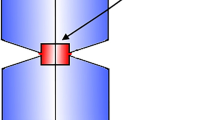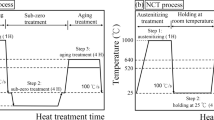Abstract
The tensile and fatigue strength of cast Mg–xNd–0.2Zn–0.45Zr alloys (x = 0, 1, 2, 3 wt%) in both solution-treated (T4) and solution + 200 °C peak-aged (T6-PA) conditions were investigated in the present study. The results indicate that Neodymium (Nd) is an effective element to improve both the tensile and fatigue properties of cast Mg–0.2Zn–Zr alloys. The strengthening effect depends on its content in a way of power function (σ = σ0 + K C Nd n), where the power exponent n is about 0.52–0.54 for yield strength (YS) and 0.59–0.61 for fatigue strength. The yield strengthening effect of Nd element in the form of precipitates (T6-PA) is about three times of that as solution atoms (T4), while the fatigue strengthening effect of Nd element in the form of precipitates is only about 50 % higher than that as solution atoms. The improved strength (both YS and ultimate tensile strength) can lead to the same amount improvement of the fatigue strength in T4-treated alloys, while only can cause less than half improvement of the fatigue strength in T6-PA-treated alloys.








Similar content being viewed by others
References
Agnew SR, Nie JF (2010) Preface to the viewpoint set on: the current state of magnesium alloy science and technology. Scripta Mater 63:671–673
Sajuri ZB, Miyashita Y, Hosokai Y, Mutoh Y (2006) Effects of Mn content and texture on fatigue properties of as-cast and extruded AZ61 magnesium alloys. Int J Mech Sci 48:198–209
Lu Y, Taheri F, Gharghouri MA, Hand HP (2009) Experimental and numerical study of the effects of porosity on fatigue crack initiation of HPDC magnesium AM60B alloy. J Alloys Compd 470:202–213
Horstemeyer MF, Yang N, Gall K, McDowell DL, Fan J, Gullett PM (2004) High cycle fatigue of a die cast AZ91E-T4 magnesium alloy. Acta Mater 52:1327–1336
Xu DK, Liu L, Xu YB, Han EH (2008) The fatigue behavior of I-phase containing as-cast Mg–Zn–Y–Zr alloy. Acta Mater 56:985–994
Chapetti MD, Tagawa T, Miyata T (2003) Ultra-long cycle fatigue of high-strength carbon steels part II: estimation of fatigue limit for failure from internal inclusions. Mater Sci Eng A 356:236–244
Liu WC, Dong J, Zhang P, Korsunsky AM, Song X, Ding WJ (2011) Improvement of fatigue properties by shot peening for Mg–10Gd–3Y alloys under different conditions. Mater Sci Eng A 528:5935–5944
Li ZM, Fu PH, Peng LM, Becker EP, Wu GH (2013) Influence of solution temperature on fatigue behavior of AM-SC1 cast magnesium alloy. Mater Sci Eng, A 565:250–257
Cáceres CH, Poole WJ, Bowles AL, Davidson CJ (2005) Section thickness, macrohardness and yield strength in high-pressure diecast magnesium alloy AZ91. Mater Sci Eng A 402:269–277
Liu ZJ, Wu GH, Liu WC, Pang S, Ding WJ (2012) Effect of heat treatment on microstructures and mechanical properties of sand-cast Mg–4Y–2Nd–1Gd–0.4Zr magnesium alloy. T Nonferr Metal Soc 22:1540–1548
Dunlop G, Bettles CJ, Griffiths JR et al (2003) The effect of grain size on the bolt load retention behaviours of AMC-SC1. In: Kainer KU (ed) The 6th International Conference Magnesium Alloys and Their Applications. Wolfsburg, Germany, pp 100–105
Uematsu Y, Tokaji K, Kamakura M, Uchida K, Shibata H, Bekku N (2006) Effect of extrusion conditions on grain refinement and fatigue behaviour in magnesium alloys. Mater Sci Eng A 434:131–140
Fu PH, Peng LM, Jiang HY, Chang JW, Zhai CQ (2008) Effects of heat treatments on the microstructures and mechanical properties of Mg–3Nd–0.2Zn–0.4Zr (wt%) alloy. Mater Sci Eng A 486:183–192
Fu PH, Peng LM, Jiang HY, Ma L, Zhai CQ (2008) Chemical composition optimization of gravity cast Mg–yNd–xZn–Zr alloy. Mater Sci Eng A 496:177–188
Li ZM, Fu PH, Peng LM, Wang YX, Jiang HY (2013) Strengthening mechanisms in solution treated Mg–yNd–zZn–xZr alloy. J Mater Sci 48:6367–6376. doi:10.1007/s10853-013-7436-0
Li ZM, Luo AA, Wang QG, Peng LM, Fu PH, Wu GH (2013) Effects of grain size and heat treatment on the tensile properties of Mg–3Nd–0.2Zn (wt%) magnesium alloys. Mater Sci Eng A 564:450–460
Wang QG (2003) Microstructure effects on the tensile and fracture behavior of aluminum casting alloys A356/357. Metall Mater Trans A 34:2887–2899
Li ZM, Fu PH, Peng LM, Wang YX, Jiang HY, Wu GH (2013) Comparison of high cycle fatigue behaviors of Mg–3Nd–0.2Zn–Zr alloy prepared by different casting processes. Mater Sci Eng A 579:170–179
Fu PH, Peng LM, Jiang HY, Zhai CQ, Gao X, Nie JF (2007) Zr-containing precipitations in Mg–3 wt%Nd–0.2 wt%Zn–0.4 wt%Zr alloy during solution treatment at 540 °C. Mater Sci Forum 546–549:97–100
Bettles CJ, Gibson MA, Zhu SM (2009) Microstructure and mechanical behaviour of an elevated temperature Mg-rare earth based alloy. Mater Sci Eng A 505:6–12
Sha G, Zhu HM, Liu JW, Luo CP, Liu ZW, Ringer SP (2012) Hydrogen-induced decomposition of Zr-rich cores in an Mg−6Zn−0.6Zr−0.5Cu alloy. Acta Mater 60:5615–5625
Hisa M, Barry JC, Dunlop GL (2002) New type of precipitate in Mg-rare-earth alloys. Phil Magn 82:497–510
Basquin OH (1910) The exponential law of endurance tests. Proc ASTM 10:625–630
Man J, Obrtlik K, Blochwitz C, Polak J (2002) Atomic force microscopy of surface relief in individual grains of fatigued 316L austenitic stainless steel. Acta Mater 50:3767–3780
Polak J, Man J, Vystavel T, Petrenec M (2009) The shape of extrusions and intrusions and initiation of stage I fatigue cracks. Mater Sci Eng A 517:204–211
Robson JD, Stanford N, Barnett MR (2011) Effect of precipitate shape on slip and twinning in magnesium alloys. Acta Mater 59:1945–1956
Avedesian MM, Baker H (1999) Magnesium and magnesium Alloys. ASM, USA
Shiozawa K, Kashiwagi T, Murai T, Takahashi T (2010) Fatigue behaviour and fractography of extruded AZ80 magnesium alloys in very high cycle regime. Procedia Eng 2:183–191
Liu WC, Dong J, Zhang P, Yao ZY, Zhai CQ, Ding WJ (2009) High cycle fatigue behavior of as-extruded ZK60 magnesium alloy. J Mater Sci 44:2916–2924. doi:10.1007/s10853-009-3385-z
Gao X, Nie JF (2007) Characterization of strengthening precipitate phases in a Mg–Zn alloy. Scripta Mater 56:645–648
Acknowledgements
This work was supported by the National Natural Science Foundation of China (51201103). The authors are grateful to Prof. Wengjiang Ding (SJTU), Dr. Qigui Wang (GM) and Dr. Alan. Luo (GM) for their helpful discussions.
Author information
Authors and Affiliations
Corresponding author
Rights and permissions
About this article
Cite this article
Peng, L., Fu, P., Li, Z. et al. High cycle fatigue properties of cast Mg–xNd–0.2Zn–Zr alloys. J Mater Sci 49, 7105–7115 (2014). https://doi.org/10.1007/s10853-014-8417-7
Received:
Accepted:
Published:
Issue Date:
DOI: https://doi.org/10.1007/s10853-014-8417-7




